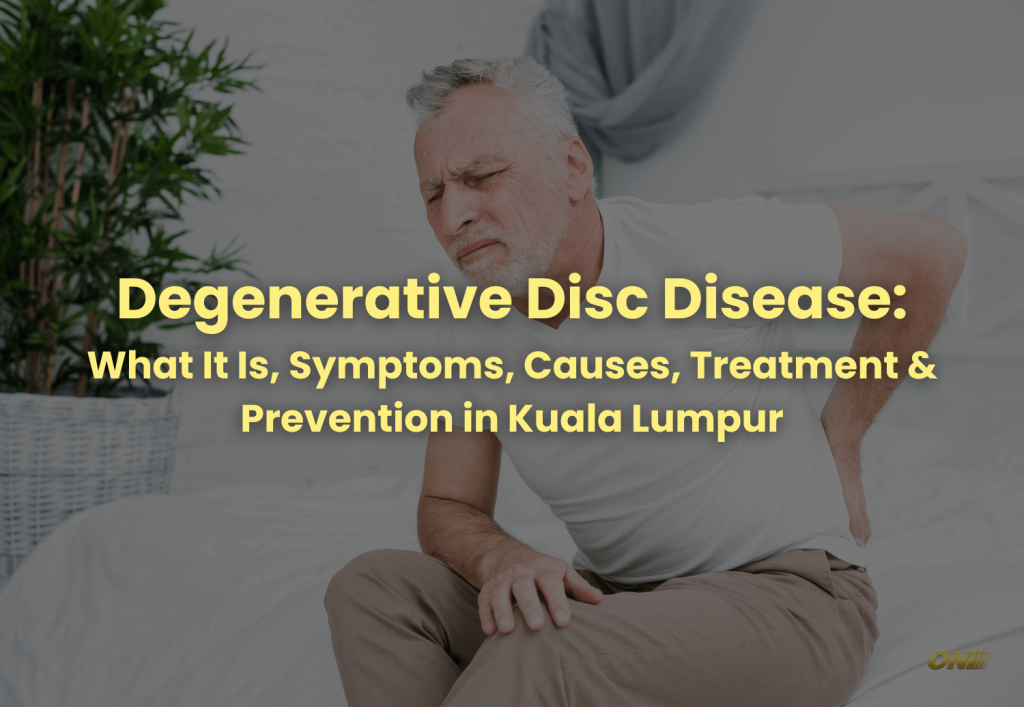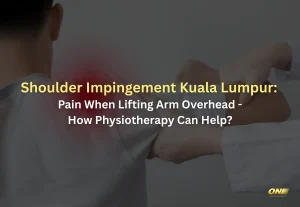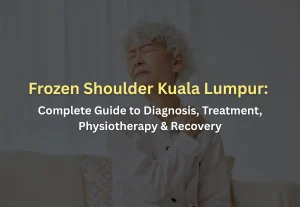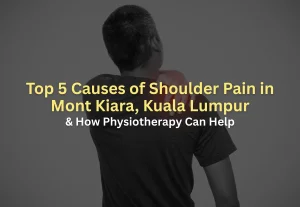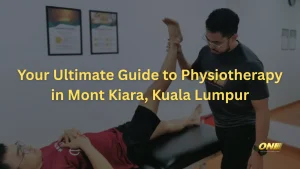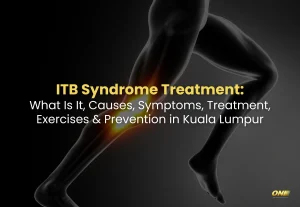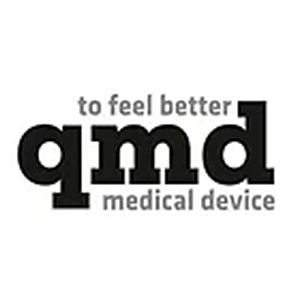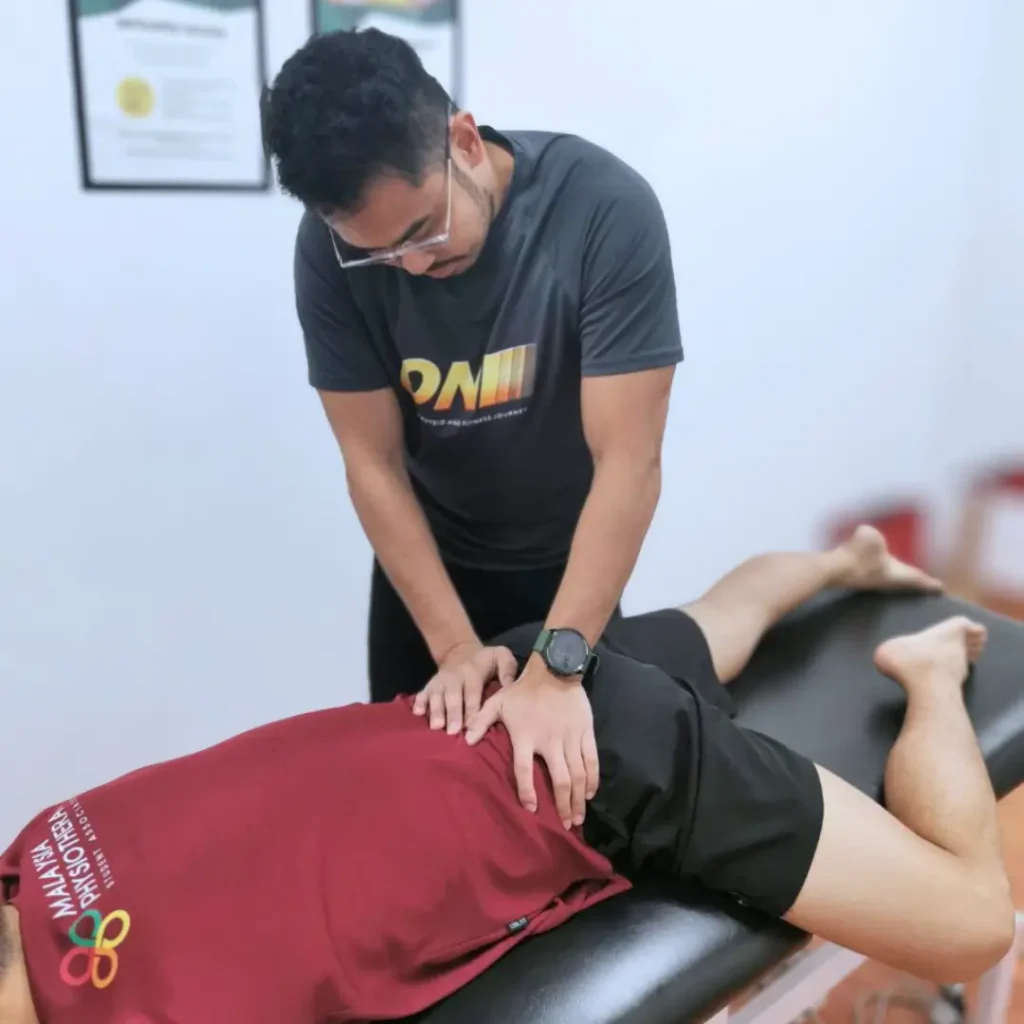Introduction
Back pain is a common complaint that can affect your quality of life, limiting your ability to perform daily activities. One of the underlying causes of persistent back pain can be degenerative disc disease (DDD). This condition, which affects the spine, can lead to chronic discomfort and mobility issues. Understanding degenerative disc disease, its symptoms, causes, and treatment options is crucial for managing your health.
In this blog post, we’ll explore everything you need to know about DDD, including how physiotherapy can play a significant role in managing this condition. If you’re located in Mont Kiara or Kuala Lumpur, ONI Physio Fitness is here to provide expert care and support.
What Is Degenerative Disc Disease?
Degenerative disc disease (DDD) is a condition that involves the gradual deterioration of the intervertebral discs in your spine. These discs act as shock absorbers between the vertebrae, allowing for flexibility and movement. As we age, these discs can wear down, losing their ability to cushion the vertebrae effectively. This degeneration can lead to pain, stiffness, and other symptoms commonly associated with a degenerative spine.
Despite its name, degenerative disc disease is not actually a disease but a condition caused by the natural aging process or injury. The degeneration of the discs can result in a narrowing of the space between the vertebrae, leading to increased stress on the spine and contributing to back pain.
Degenerative Disc Disease Symptoms
The symptoms of degenerative disc disease can vary depending on the severity and location of the affected discs. Common symptoms include:
- Chronic pain: Persistent pain in the lower back, neck, or middle back.
- Pain that worsens with movement: Activities such as bending, lifting, or twisting can exacerbate the pain.
- Numbness or tingling: These sensations may occur in the arms or legs if the nerves are affected.
- Weakness: Muscle weakness in the affected area can result in difficulty performing certain tasks.
- Reduced mobility: Stiffness and pain can limit your range of motion, making it hard to move freely.
It’s important to note that the severity of symptoms does not always correlate with the degree of disc degeneration. Some people may experience significant disc degeneration with minimal pain, while others may have severe symptoms with less disc damage.
Degenerative Disc Disease Causes
Degenerative disc disease is primarily caused by the natural aging process, but several factors can contribute to or accelerate the degeneration of spinal discs:
- Aging: As you age, the discs in your spine lose water content, becoming thinner and less flexible. This natural wear and tear can lead to degeneration.
- Injury: An acute injury or repetitive strain on the spine can cause the discs to deteriorate more quickly.
- Genetics: Some individuals may be genetically predisposed to developing degenerative disc disease.
- Obesity: Excess body weight puts additional stress on the spine, accelerating disc degeneration.
- Smoking: Smoking can reduce blood flow to the discs, hindering their ability to repair and maintain themselves.
Degenerative Disc Disease Diagnosis
Diagnosing degenerative disc disease typically involves a combination of a physical examination and imaging tests. During the physical exam, your doctor or physiotherapist will assess your range of motion, reflexes, and muscle strength, as well as review your symptoms and medical history.
At ONI Physio Fitness in Mont Kiara, Kuala Lumpur, our experienced physiotherapists can assess your condition thoroughly. We use specific tests to determine if degenerative disc disease is the source of your pain and discomfort. If necessary, we may recommend imaging tests such as X-rays, MRI, or CT scans to confirm the diagnosis and assess the extent of disc degeneration.
Degenerative Disc Disease Treatment
Treatment for degenerative disc disease focuses on managing symptoms, improving function, and preventing further degeneration. While there is no cure for DDD, several treatment options can help you manage the condition effectively.
Physiotherapy
Physiotherapy is one of the most effective treatments for degenerative disc disease. At ONI Physio Fitness in Mont Kiara, Kuala Lumpur, our skilled physiotherapists will develop a personalized treatment plan to address your specific needs. Physiotherapy can help reduce pain, improve mobility, and strengthen the muscles that support your spine.
Our physiotherapy approach may include:
- Manual therapy: Hands-on techniques to relieve pain and improve joint mobility.
- Exercise therapy: Targeted exercises to strengthen the core, back, and other supporting muscles, reducing stress on the spine.
- Postural training: Guidance on proper posture to minimize strain on the discs and prevent further degeneration.
- Pain management techniques: Education on how to manage pain effectively through lifestyle modifications and therapeutic interventions.
Other Treatment Options
- Medications: Pain relievers, anti-inflammatory drugs, or muscle relaxants may be prescribed to manage pain and inflammation.
- Epidural steroid injections: In some cases, corticosteroid injections may be used to reduce inflammation and relieve pain.
- Surgery: Surgery is typically considered a last resort and may involve procedures such as spinal fusion or disc replacement for severe cases.
Rehab Exercises for Degenerative Disc Disease
Rehabilitation exercises are a crucial part of managing degenerative disc disease. These exercises can help to improve strength, flexibility, and stability in the spine. Here are three effective exercises to try:
1. Child’s Pose
- Start on your hands and knees in a tabletop position.
- Sit back onto your heels while stretching your arms out in front of you, lowering your chest toward the floor.
- Hold the stretch for 20-30 seconds, focusing on deep, relaxed breathing.
- Return to the starting position and repeat 3-5 times.
2. Pelvic Tilts
- Lie on your back with your knees bent and feet flat on the floor, hip-width apart.
- Gently flatten your lower back against the floor by tightening your abdominal muscles.
- Hold the position for 5 seconds, then relax.
- Repeat 10-15 times, gradually increasing the duration of the hold as you become stronger.
3. Knee-to-Chest Stretch
- Lie on your back with your knees bent and feet flat on the floor.
- Bring one knee towards your chest, holding it with both hands.
- Hold the stretch for 20-30 seconds, then return to the starting position.
- Repeat with the opposite leg, and do 3-5 repetitions on each side.
Our physiotherapists at ONI Physio Fitness can guide you through these exercises and ensure they are performed correctly to maximize their benefits.
How to Prevent Degenerative Disc Disease?
Preventing degenerative disc disease involves taking proactive steps to protect your spine and maintain its health. Here are some tips to help reduce your risk:
- Maintain good posture: Whether sitting, standing, or lifting, always be mindful of your posture to avoid putting extra stress on your spine.
- Exercise regularly: Keep your core and back muscles strong with regular exercise to support your spine.
- Lift properly: Use your legs, not your back, when lifting heavy objects, and avoid twisting your body while lifting.
- Maintain a healthy weight: Excess weight can strain your spine, so maintaining a healthy weight can help prevent disc problems.
- Quit smoking: Smoking can reduce blood flow to the discs, increasing the risk of disc degeneration.
Conclusion
Degenerative disc disease is a common condition that can lead to chronic back pain and reduced mobility. While the condition cannot be cured, it can be managed effectively with the right treatment approach. Physiotherapy is a key component in managing DDD, helping to alleviate pain, improve function, and prevent further degeneration. If you’re experiencing symptoms of degenerative disc disease, visit ONI Physio Fitness in Mont Kiara, Kuala Lumpur. Our expert physiotherapists are here to assess your condition and create a personalized treatment plan to help you live a pain-free life.
Don’t let degenerative disc disease hold you back. Contact ONI Physio Fitness today to schedule your assessment and start your journey toward better spine health!

